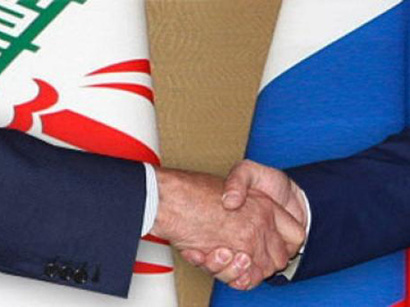Iran calls for using national currencies in trade with Russia

By Sara Rajabova
Moscow and Tehran have recently increased efforts to expand their economic and trade relations.
Iran’s Minister of Communication and IT, Mahmoud Vaezi, visited Moscow with a delegation of 70 traders as the two major allies fast-tracked their expansion of ties in time for the lifting of sanctions.
Vaezi, who was in Moscow for the 12th meeting of the Iran-Russia joint economic commission, has called for trade to be paid for using national currencies, Iran’s Fars news agency reported.
Vaezi underlined that boosting banking cooperation will prepare the ground for more Tehran-Moscow cooperation.
Earlier it was reported that the Islamic Republic has launched ruble/rial trade with Russia. Gholam Reza Panahi, the deputy governor for currency affairs of Bank Melli of Iran, said in late April that a mechanism that enables Iranian exporters to transfer payments in rubles from their Russian clients to Iran through the Moscow-based Mir Business Bank has been established.
Iran also said it plans to establish joint rial accounts for Russian banks in Iran, which would enable Iranian exporters to receive payments in rials for their exports to Russia.
During Vaezi’s visit to Moscow several key issues, including Russia’s plans to open a $5 billion credit line for Iran, the idea of establishing a joint bank and Iran’s membership in the Eurasian Development Bank, were on the agenda for discussions.
The two countries are also working to create a joint bank and carry out their transactions in their national currencies.
Vazei’s visit follows Novak’s trip to Tehran last month, with a large delegation of representatives from 50 Russian companies.
Before it plunged to $2 billion, Iranian-Russian trade turnover was $4 billion in 2013.
Earlier, Novak said Iran and Russia intend to invest $35-40 billion in joint medium-term projects.
Andrey Lugansky, Russian trade representative in Iran, told Russian media that Russia and Iran should use currencies of third countries, where Iran supplies its oil, to develop economic relations.
While speaking of the difficulties in the supply of grain from Russia to Iran, he said there are two major problems to overcome.
"The first problem is quite high Russian prices. The second problem is that Iranian traders need rubles to purchase grain in Russia," he said.
He said Iranian banks have many currencies of third-countries, including Chinese yuan, South Korean won, Japanese yen, and others, because Iranian oil and petrochemicals are supplied to these countries.
Lugansky added that, however, they are not supplied to Russia, noting that Iranian banks have few rubles to convert rials into rubles to purchase goods.
He also said an oil-for-assets barter deal between Iran and Russia is still in force, but low oil prices are preventing them from carrying out this arrangement.
"Oil has fallen in price from the time the deal was signed, and this has become an objective obstacle to selling Iranian oil in any market. The program works, but so far with no results," Lugansky said.
The two countries have agreed on an oil-for-goods swap worth $1.5 billion per month under which Russia would buy up to 500,000 barrels per day of Iranian oil in exchange for Russian equipment and goods.
Oil prices have slumped from $100 to under $50 per barrel since summer 2014, primarily as a result of global oversupply.
There are few details about the barter arrangement. Under the deal, Iran is about to receive cash, Russian goods and services for the oil which is sold, according to Iranian officials.
--
Sara Rajabova is AzerNews’ staff journalist, follow her on
Twitter: @SaraRajabova
Follow us on Twitter @AzerNewsAz
Here we are to serve you with news right now. It does not cost much, but worth your attention.
Choose to support open, independent, quality journalism and subscribe on a monthly basis.
By subscribing to our online newspaper, you can have full digital access to all news, analysis, and much more.
You can also follow AzerNEWS on Twitter @AzerNewsAz or Facebook @AzerNewsNewspaper
Thank you!
